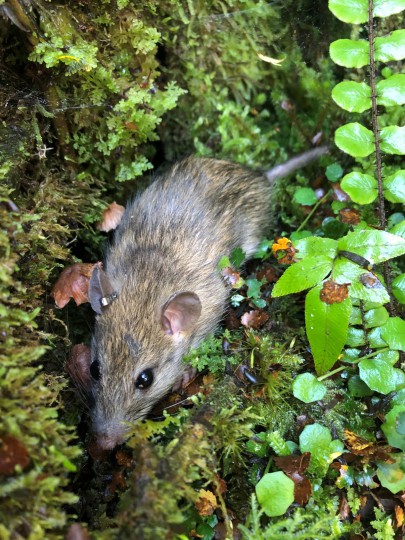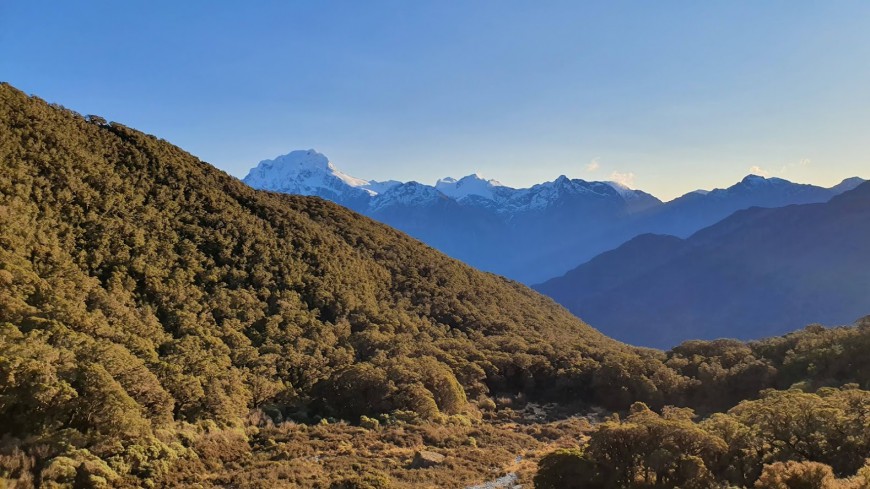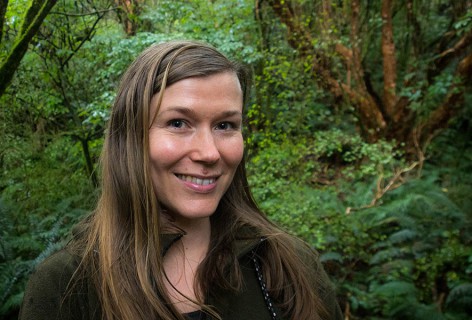
Tagged rat. Image: Morgan Coleman
But scientists are hoping that understanding how altitude and food availability regulate rat numbers will give conservationists the edge in protecting wildlife from rat plagues, which can lead to localised extinctions of native wildlife.
“Rats are generally less common in cold, high altitude forests across New Zealand than in warm, lowland forests,” says study lead Dr Jo Carpenter, a postdoctoral researcher at Manaaki Whenua. “But it’s not clear whether that’s because rats can’t handle cold temperatures, or because there is typically less food, especially in winter, for rats in cold, high elevation forests.”
To tease these factors apart, the team of researchers have been intensively monitoring rat population dynamics at both high and low elevations at Lake Alabaster, Fiordland. Rats at high elevation are actually being fed to see whether they can survive cold temperatures when they have sufficient food.
“This is a really relevant question, because if it’s temperature that normally limits rats from living up high, and not food, we might expect to see high elevation forests supporting more rats as the climate warms,” warned Manaaki Whenua researcher Dr Adrian Monks. “This could have devastating consequences for some of our birds, which currently use these environments as refugia from pests.”
“In the meantime, the study has direct implications for current pest control programmes,” says DOC science advisor Dr James Griffiths. “Cost-effective pest management relies on knowing where and when pest numbers are high so management can be focused on the right place at the right time. This study is going to help us a lot with that, and ought to result in improved pest control and healthier forests.”
Since the study began 14 months ago, 912 individual rats have been live-captured in cage traps at the site. The researchers give each rat a unique ID by inserting a microchip under the rat’s skin – like the type used for pet dogs – and placing a metal tag in their ear. The rat is then released. While releasing a rat goes against the grain for most conservationists, the team can then calculate how many rats live in an area by looking at the proportion of marked and unmarked rats they capture.
“This is one of the first studies to estimate the density of rats in South Island forests,” comments Manaaki Whenua researcher John Innes. “Normally, ecologists obtain relative measures of rat abundance or activity. While this is useful and reasonably easy to do, we often don’t actually know how those estimates relate to the number of rats that occupy an area.”
The preliminary results have been startling. Following the beech seed mast in 2019, rats at Lake Alabaster reached a phenomenal 17 rats per hectare. These are some of the highest rat densities ever measured on the New Zealand mainland, and reflect the incredible ability of rats to multiply rapidly following beech seeding.

The study site. Image: Jamie McAulay, DOC
But is the extra food making a difference to whether rats can survive up high? “We’re still monitoring the population,” cautions Carpenter, “but it seems that food helped sustain the rats through the autumn. When we reached winter, though, the fed rats declined as much as the rats we didn’t feed. This suggests that another factor – perhaps temperature or predation by stoats – is limiting rats.”
“One of the hardest parts of this study,” says Carpenter, “is letting the rats go.” In order to get a true idea of pest densities, the team uses live-capture traps, releasing the rats to live another day. But they hope it will all be worth it in the end. The study is part of a five-year research program titled ‘More Birds in the Bush’, funded by the Ministry of Business, Innovation, and Employment’s Endeavour fund. A key aim of the program is to create a kind of “weather forecast about rats”, where conservation managers will be able to predict what rats will do based on the climate and forest at their site. In turn, this will allow rat control to be done as effectively as possible, resulting in more birds in the bush.

